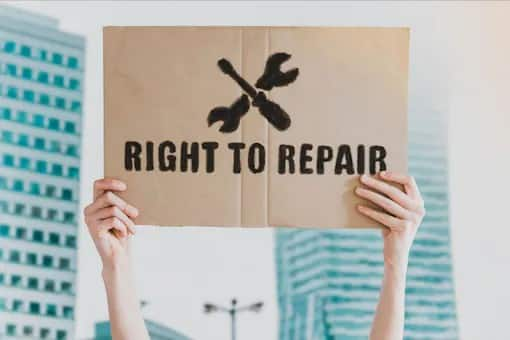Is your laptop malfunctioning? Is your cellphone out of order? Facing long waits to get your gadget repaired or having to toss them out entirely and pick up a new one may soon be a thing of the past. The Department of Consumer Affairs said in a statement on Thursday that it has set up a committee chaired by Additional Secretary Nidhi Khare to develop comprehensive framework on ‘Right to repair’. Let’s take a closer look at the ‘Right to repair’, why the committee was set up and what it hopes to achieve: What is ‘Right to repair’? First, let’s understand that manufacturers in general retain proprietary control over the design of the products and their spare parts. Warranty cards of several products such as TVs and cars state that getting them repaired from an outfit not recognised by the makers would lead to customers losing their warranty.
In the view of the Centre, this sort of monopoly on the repair processes infringes the customer’s “right to choose”.
As per the Centre, the rationale behind the ‘Right to repair’ is that when customers buy a product, it is inherent that they must own it completely “for which the consumers should be able to repair and modify the product with ease and at reasonable cost, without being captive to the whims of manufacturers for repairs.” The government plans to make it mandatory for makers of cars, mobiles and other consumer goods monopolising repair and spare parts market to share with customers product details necessary for repair by self or by self or third parties. As per The Times of India, it will be mandatory for manufacturers to give the detailed drawings of the products at the time of sale. Repair is a critical function of all forms of re-use and even for the sustainable life of the products, the ministry said. A product that cannot be repaired or falls under planned obsolescence like designing a product with an artificially limited useful life, not only becomes e-waste but also forces the consumers to buy new products for want of any repair to reuse it, it added. [caption id=“attachment_10911571” align=“alignnone” width=“640”]  Repair is a critical function of all forms of re-use and even for the sustainable life of the products, the ministry said. News18[/caption] Thus, restricting the repair of products forces consumers to deliberately make a choice to purchase a new model of that product, the ministry said, as per the report. The ministry said it has been noted that not only there is a considerable delay in repair but at times the products are repaired at an exorbitantly high price and the consumer who has once bought the product is hardly given any choice. Often the spare parts are not available, which causes consumers great distress and harassment, the ministry added, as per the report. What is the aim of ‘Right to repair’? To empower consumers, harmonise trade between the original equipment manufacturers and the third-party buyers and sellers, and reduce e-waste. The moves comes in a bid to put a greater emphasis on Lifestyle for the Environment (LiFE) movement through sustainable consumption which was launched by Prime Minister Narendra Modi last month.
This includes the concept of reusing and recycling various consumer products.
Committee identifies key sectors The committee held its first meeting on Wednesday in which key sectors for ‘Right to repair’ including farming equipment, mobile phones/ tablets, consumer durables and automobiles/automobile equipment were identified. “The pertinent issues highlighted during the meeting include companies avoid the publication of manuals that can help users make repairs easily,” the ministry said “Manufacturers have proprietary control over spare parts, regarding the kind of design they use for screws and other items. Monopoly on repair processes infringes the customer’s “right to choose”, it said. Further, the department noted that digital warranty cards, ensure that by getting a product from a ’non-recognised’ outfit, the customer loses the right to claim a warranty. “Manufacturers are encouraging a culture of ‘planned obsolescence’. This is a system whereby the design of any gadget is such that it lasts a particular time only and after that particular period it has to be mandatorily replaced,” the statement added. “During the deliberations, it was felt that the tech companies should provide complete knowledge and access to manuals, schematics, and software updates and to which the software license shouldn’t limit the transparency of the product in sale,” it said. Further, the parts and tools to service devices, including diagnostic tools should be made available to third parties, including individuals so that the product can be repaired in case of minor glitches. “Fortunately, in our country, there exists a vibrant repair service sector and third party repairs, including those who cannibalise the products for providing spare parts for circular economy,” the statement said. Once rolled out in India, the framework will become a “game-changer” for the sustainability of the products and serve as a catalyst for employment generation through Aatmanirbhar Bharat by allowing third-party repairs, the ministry said. ‘Right to repair’ abroad The right to repair has been recognised in many countries across the globe, including the USA, UK and European Union. [caption id=“attachment_10911601” align=“alignnone” width=“510”]  Representational image. News18[/caption] As per The Hindu, New York state recently passed the Fair Repair Act, which requires manufacturers to supply repair information, tools, and parts to independent repair shops and not just their own stores or partners. The Act gives consumers with the right to repair and refurbish their purchased goods as well as allows independent repair shops to access relevant tools and repair manuals and compete with manufacturers. As per News18, the US Federal Trade Commission has ordered manufacturers to remedy unfair, anti-competitive practices and to make sure consumers can make repairs, either themselves or by a third-party agency. Meanwhile, the UK has a law that mandates all electronic appliance manufacturers must provide consumers with spare parts for repair either by themselves or at local repair shops. Australia has free “repair cafes”, where technicians volunteer to share skills for free, while the European Union has made it legally mandatory for manufacturers to provide parts of products to professional repairmen for a period of 10 years, as per the report. With inputs from agencies


)

)
)
)
)
)
)
)
)



